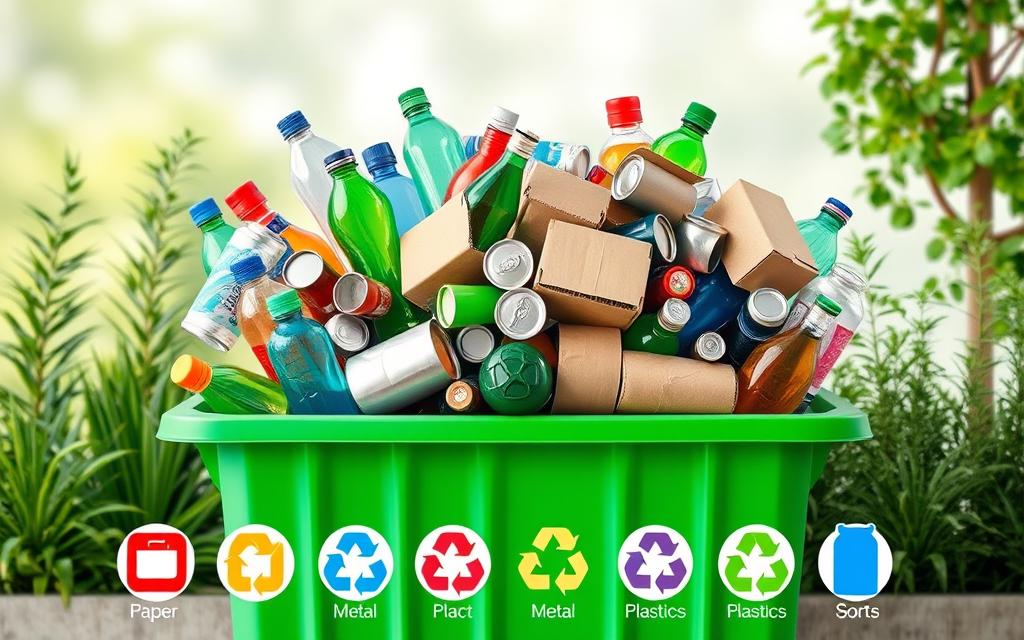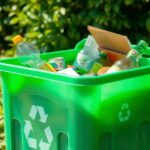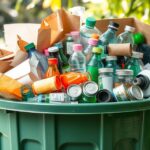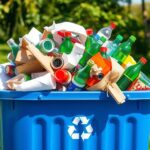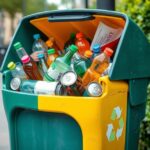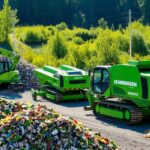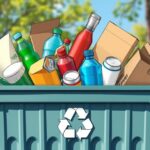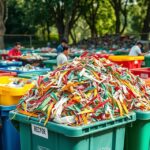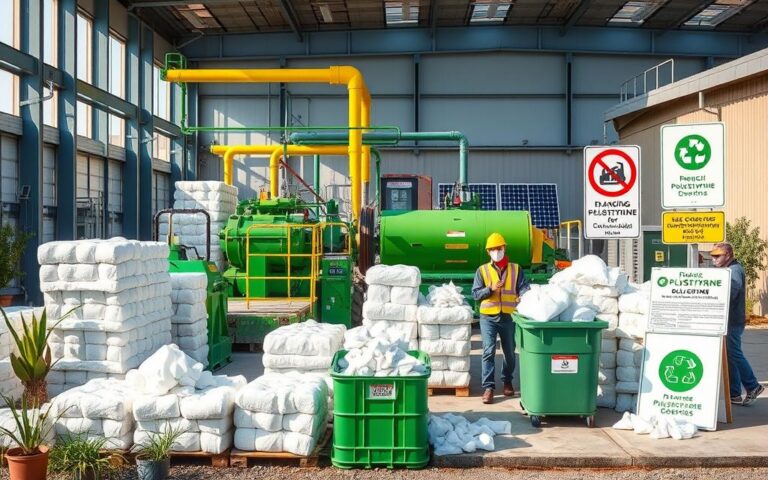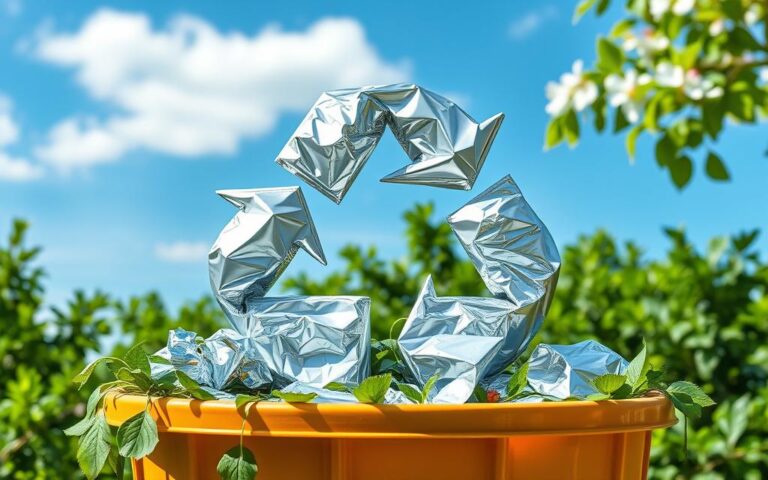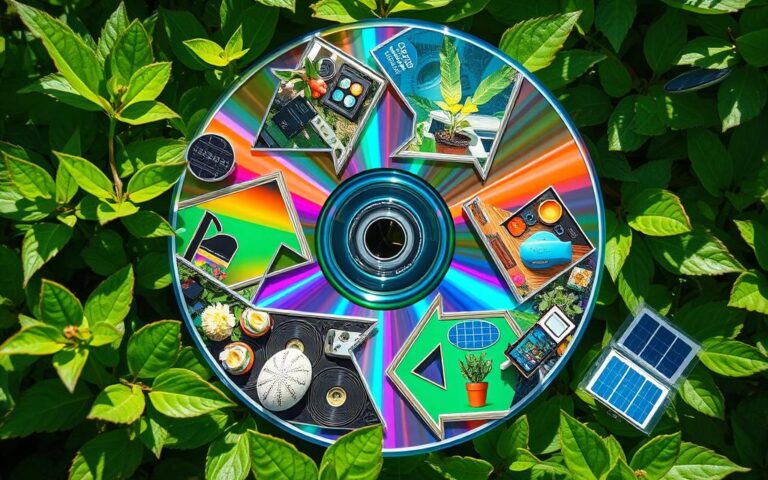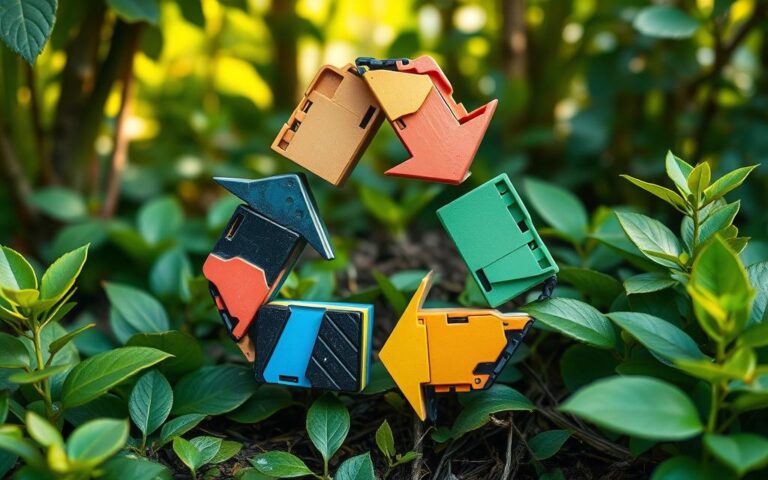What Goes in the Green Recycling Bin? Proper Sorting Guide
Knowing what goes in the green recycling bin is important for the planet. This guide helps you understand which materials are right for your green bin. By sorting your recyclables correctly, you help make recycling more efficient.
Correct sorting lowers the chance of recyclable materials getting contaminated. In San Francisco, experts have set clear rules for what belongs in compost, recycling, or trash. By following these rules, you help create cleaner recycling streams and practise good waste management.
Understanding the Importance of Recycling
Recycling is key for a healthier planet, ensuring a better tomorrow. It’s crucial, especially as waste keeps growing. The UK plans to recycle 65% of its municipal waste by 2035. This needs a boost in our recycling efforts and a deeper awareness of its benefits.
Environmental Benefits
Recycling helps in cutting down greenhouse gas emissions. It also saves our planet’s precious resources. For example, recycling old aluminium saves up to 95% of the energy needed to make new aluminium from scratch.
This means huge energy savings. Recycling steel uses 70% less energy. Similarly, making paper from recycled ones needs 40% less energy than from new wood. Even recycling a single glass bottle can save enough energy to light a 100-watt bulb for 4 hours.
Reducing Landfill Waste
Good recycling habits greatly cut down landfill waste. Lambeth council in London found recycling to be six times cheaper than dealing with regular rubbish. Landfills keep growing with household and business waste, a problem made worse by more people.
Landfills also hurt our plants and animals. About 85% of endangered species are in danger mainly because their homes are turned into landfills. Better recycling can reduce waste and help save these species and their living spaces.
What Goes in the Green Recycling Bin?
Sorting waste properly is key to effective recycling and composting. Putting the right things in the green bin helps keep valuable resources out of landfills. This makes our environment healthier. We will cover what items are good for the green bin. These include food scraps and yard waste.
Acceptable Composting Materials
Composting is vital for managing waste well. The green bin is for organic stuff that decomposes naturally. Items perfect for this bin include:
- Fresh fruit and vegetable scraps
- Eggshells
- Coffee grounds and filters
- Grass clippings, which can weigh over 300 pounds per 1,000 square feet annually
- Leaves and yard debris
- Small branches and twigs
Food Scraps and Yard Debris
Food scraps are crucial for top-notch compost. Both cooked food leftovers and uncooked food waste are important. These scraps, along with yard waste like leaves and cuttings, create a balanced compost mix. Knowing what goes into the green bin helps make great compost. It also keeps the recycling process clean and efficient.
Paper and Plant Materials
Some papers and plant bits are also great for compost bins. Look for things like non-shiny cardboard, paper towels, and shredded newspaper. Even dead flowers and cut herbs can go in. Sorting these items right helps your green bin support the best composting process. This follows waste management rules too.
| Type of Material | Examples | Benefits |
|---|---|---|
| Food Scraps | Fruit peels, vegetable trimmings, eggshells | Rich in nutrients, promotes healthy compost |
| Yard Debris | Grass clippings, leaves, small branches | Reduces waste volume, provides carbon for compost |
| Paper Products | Shredded newspaper, cardboard, paper towels | Enhances compost structure, adds organic matter |
Following these tips improves composting efforts and aids waste reduction goals. Knowing acceptable materials for the green bin encourages a cleaner, greener community.
Common Items to Avoid in the Green Bin
It’s important to know what shouldn’t go in the green recycling bin. This helps keep recycling practices effective. This guide covers types of items that should stay out of the green bin.
Unacceptable Food Waste
Not all food waste is suitable for composting. Foods like meats, dairy, and items high in oil or fat can cause issues. They attract unwanted animals and can make the compost smell bad, leading to contamination.
These types of food waste need to be thrown away differently, not just put in the landfill. It’s part of being sustainable.
Contaminants That Disrupt Recycling
Certain items should never go in the green bin as they can’t be recycled. These include:
- Dirty diapers
- Hangers
- Batteries
- Rubber balls and tyres
- Flexible packaging like potato chip bags or juice pouches
- Textiles such as clothing and curtains
- Shredded paper, often too small to sort
- Glass items like windows and mirrors
- Medical waste including syringes
Avoiding these items helps keep the recycling process clean. This supports both our environment and recycling programs in the community.
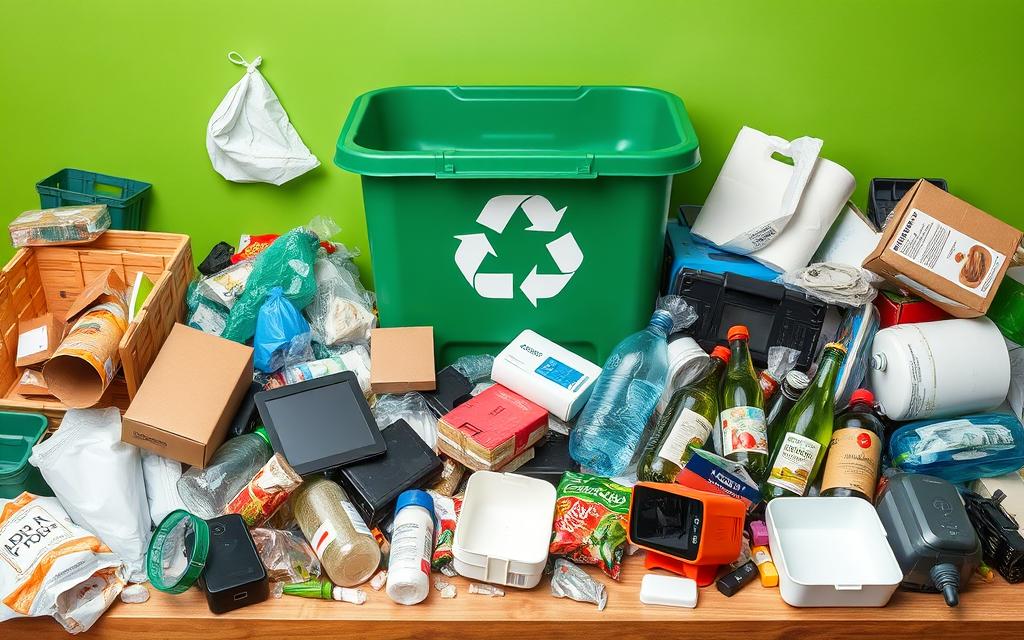
| Category | Items to Avoid | Reason for Avoidance |
|---|---|---|
| Food Waste | Meats, dairy, oily foods | Attract pests; cause odours |
| Household Items | Dirty diapers, batteries | Contaminate recycling; hazardous materials |
| Flexible Packaging | Potato chip bags, juice pouches | Made from multiple materials; non-recyclable |
| Textiles | Clothing, curtains | Not accepted in curbside recycling |
| Glass Items | Windows, mirrors | Not recyclable in side bins |
Tips for Proper Sorting at Home
Sorting waste correctly at home simplifies recycling and helps the planet. These tips will make it easier to recycle the right way and keep unwanted materials out. Knowing how to set up a good system is useful for you and the Earth.
Setting Up a Sorting System
Start with separate bins for different waste types. This makes sorting easier and more efficient. Here’s how to get your system right:
- Place bins for paper, plastics, and metals where you can easily get to them.
- Keep a bin for compostable stuff, especially in the kitchen.
- Use labels and stickers on each container so everyone knows where things go.
Using Visual Aids for Better Recycling Compliance
Visual aids improve recycling habits and understanding. They make sorting materials correctly fun for the whole family. Think about these ideas:
- Create guides showing what to recycle, compost, or trash.
- Use bins with holes for better airflow, keeping compostables odorless longer.
- Teach your family to avoid non-recyclables like paper clips and dirty diapers.
Using these tips can make your home more recycling-friendly. Getting involved in community recycling, like being a block leader, helps even more. Your efforts will reduce waste in landfills together.
| Material Type | Recyclable | Compostable | Non-Recyclable |
|---|---|---|---|
| Paper | Yes | Wet paper (limited) | Paper clips, laminates |
| Plastics | Yes (check local codes) | No | Food wrappers, certain films |
| Metals | Yes | No | Non-recyclable foil |
| Food Scraps | No | Yes | Meat (if not compostable) |
| Glass | Yes (for most types) | No | Broken glass and ceramics |
Local Resources and Regulations
Understanding how to recycle properly is key to waste management. Every area has its own rules for recycling. This makes it important for people to know what can be recycled and where to take it. Resources in the community help people follow these rules.
Finding Your Local Recycling Guidelines
Start by visiting your local council’s website to find recycling information. You will find details like:
- Which materials are recyclable, including paper, cardboard, glass, metal, and certain plastics such as #1, #2, and #5.
- Changes to collection times during holidays, which may push pickup to the next week.
- Limits on certain items, for example, plastic bags may not be picked up at the curb.
Utilising Community Resource Centres
Community centres help with recycling too. They provide extra places to drop off recyclables, in addition to curbside service. For example, Philadelphia has six spots where you can bring many different items. Metals, glass bottles, jars, and specific plastics are accepted there.
It’s important to keep harmful items out of recycling bins. Local centres advise on how to do this safely. By using these services, people help the environment while following guidelines.
Conclusion
Knowing what goes into the green recycling bin is key for good recycling and helping the environment. Sorting waste at home is vital. It affects how much we can compost and cut down on landfill waste. Recycling awareness in our communities encourages sustainable habits and a care for our planet.
The Ley Creek Transfer Station helps residents with recycling by offering an easy way to dispose of materials at certain times. When businesses use proper mixed recycling, they look better, save money, and reduce waste contamination. This improves the environment.
By following local recycling rules, everyone can help our ecosystem flourish. For more information on recycling green waste, have a look at this enlightening article on green waste recycling. Working together, we can build a society that manages resources wisely.
FAQ
What can I put in my green recycling bin?
You can put clean paper, cardboard, and garden waste in your green bin. Some food scraps are okay too. But make sure to check your local rules to follow your area’s recycling guidelines.
Are there any food items that I should avoid placing in the green bin?
Yes, do not put meat, dairy, and oils in the green bin. These items can ruin the recycling process. Only compostable scraps like fruit and veg peels should go in.
How can I improve my sorting process at home?
Set up a specific spot for sorting your recycling. Use bins with labels and pictures to help. Being consistent will make recycling easier.
What should I do if I’m unsure about a particular item?
If you’re not sure, always check your local recycling rules. Many areas have websites or helplines to guide you on disposing of items properly.
Is there any impact on recycling if I mix different materials?
Mixing different materials like plastics and metals can cause problems. It makes recycling harder. Always separate materials as your local guidelines suggest.
Why is it important to understand local recycling regulations?
Knowing your local recycling rules helps make sure items are recycled right. This way, we make the most of recycling and cut down on landfill waste.
Where can I find resources about recycling in my community?
Check out your local council’s website, community centres, or educational campaigns. They offer guides and online information to help you recycle better.

